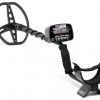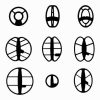
So what is the best frequency for a metal detector?
Like everything in life, it’s complicated…
Manufacturers have spent years and countless thousands of dollars to come up with a machine that has “the best frequency.” The best frequency does not exist. There is a range of frequencies that detect different metals in different ground conditions. Knowing what and where you plan on hunting and understanding what how frequency impacts detecting will help you select a metal detector that suits your needs.
Why is Frequency important?
Frequency is the number of waves emitted over a period of time. For metal detectors, the frequency is usually measured in kilohertz (kHz) or 1,000 waves per second.
Example: a 20 Khz metal detector will send and receive a signal 20, 000 times per second.
Lower Frequency Detectors
These metal detectors emit longer waves and excel at locating metals like silver, that are highly conductive. These longer waves will locate items at greater depth, but do not work as well at finding smaller lower conductivity objects. Low-frequency metal detectors are usually under 5 kHz.
High-Frequency Detectors
These metal detectors excel at locating metals like gold and iron, that have low conductivity. They emit shorter waves and are better at locating smaller objects, like little nuggets of gold or small pieces of jewelry. The higher frequency will not penetrate as deep into the ground or find high conductivity metals. High-frequency metal detectors are very sensitive to mineralization. High levels of ground mineralization can render some of these units useless. High-frequency metal detectors are usually above 15 kHz.
Mid Range Detectors
6-8 kHz is the sweet spot for most metal detectors. This range offers the best compromise between depth and sensitivity. More expensive units can use multiple frequencies at the same time or allow the user to manually set the frequency to specifically target items.
2 Types of Frequencies:
Single Frequency operation: These detectors only emit one frequency at a time. Also known as a continuous wave, a single frequency is most often found in Entry-level machines, like the Beat Frequency Oscillator including the Garrett Ace 250.
Dual or Multiple Frequency Operation: More advanced, and expensive, metal detectors can send and receive more than one frequency at a time. Also, know as full-band frequency, this technology allows for better ground penetration and accuracy. Popular detectors include Minelab Excalibur II, CTX 3030, and Etrac.
back to menu ↑Frequency and Conductivity
All metal objects conduct electricity, but some do it better than others. Low conductivity metals like gold or iron and best detected with high frequencies and high conductivity metals like silver are best located with low frequencies.
Most metal detectors can identify different types of metal by sensing how well it conducts the electricity of the pulses sent into the ground This feature is known as discrimination. Discrimination allows the metal detectors to identify different types of metal in the ground and screen out unwanted metals.
Generally speaking, low conductivity targets give a better response on detectors that operate at higher frequencies and low frequencies are best for high conductivity targets. What a lot of people fail to take into consideration is the fact that metal type is not the only factor that determines how a detector see the conductivity of a target. A US silver dollar is a good example of a high conductivity target however, the small silver hammered coins that UK detectorists seek is a low conductivity target to a metal detector. The size or mass of the target makes the difference, a large silver object has high conductivity, a small silver object has low conductivity.
The same rule applies to all metals, gold included Most natural gold nuggets found by detectorists are small, less than 1/10 of a gram. Higher frequency detectors that operate in the 50 to 70 kHz range are the most popular ones in use by nugget shooters. Now in areas where the gold typically runs larger than average, say a few grams up into the ounce range, detectors in the lower 13-19 Khz range are the best choice because of their greater depth (sensitivity) to bigger gold objects.
Frequency aside, the amount of built in sensitivity (or gain) a detector has also is a major consideration. Those high-frequency detectors in the 50-70 Khz range typically have many times the amount of built-in gain compared to lower frequency machines. That is the other part of why they are so sensitive to tiny nuggets. The downside is poor performance in highly mineralized ground conditions where the highly sensitive detector can not differentiate between gold and other minerals.
back to menu ↑Conclusion
So what is the best frequency for all-around detecting that gives good performance on a wide range of targets? Conventional wisdom used to be that the 10-12 Khz range is the best overall compromise. The newer digital designs perhaps have changed that thinking a bit.
Modern clean high gain front end designs coupled with advances in ground handling and Target ID allow higher frequencies to be used with less tradeoff on high conductive metals. In low mineral ground, using high sensitivity settings on high conductive coins about the same as that of the better low-frequency machines. The tradeoff is undesirable tiny trash targets cause a lot of ‘noise and chatter.’ The 6-9 kHz frequency range is still best for general use most of the time. this range might have to be adjusted up or down depending on the metal being targeted and the soil conditions.
There are advantages and disadvantages to detecting with higher and lower frequencies. The best frequency depends on what you are looking for and where you are hunting for it.
Find the right detector, then find your treasure!











[…] Unfortunately, it is almost impossible to predict the depth that a metal detector can search to. There are many variables that involve both the type of detector, coils and the ground that factor into the answer.Learn more on how the frequency the metal detector is using impacts on how deep it can search. […]